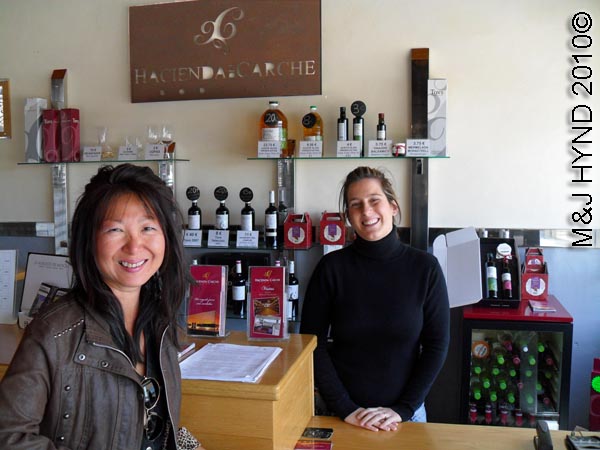Jumilla, Murcia
In Spain, you can buy wine everywhere - specialist stores, hypermarkets, shops, cafeterias, cafes, restaurants, even in the tiniest country supermarket that had only two shelves worth of groceries. As are the Bodegas, which in general is a wine store or shop, though the translation is a wine cellar.
Storing, serving, and drinking wine, savouring the smoothness; the effects of time can cause gradual changes in its flavours. In our local cafe, cafeteria-restaurant, it's possibly to buy wine in flagons or even bigger volumes. You bring your own containers, they fill them up, from the barrel. It is reasonable, and very good. Friends recommended going to a restaurant further down the road. They always had tapas; on one side of the restaurant, are 6 to 8 big barrels of wine where you self-fill your wine-glass up whenever it is empty. Choose a different wine from the barrels, you picked and tried it, or stay with the wine you've chosen. It's a mom & pop restaurant run by the owners, very casual, they charge you when you've finished your meal - but which barrels did you take the wine(s) from? And how many trips, by the time you've finished the tapas and had coffees?
Wineries in Spain where you have wine sales, and definitely wine tasting, but what of the process of making wine? ... Spain is perhaps a viti- or vini- culturist dream come true.
When visiting Spain, there is so much wine on offer at a reasonable price you might tend to only drink the wines you know and like. We generally do the same, but sometimes it’s good to have a change, perhaps visit a vineyard or two, make a day-trip, and learn new things along the way.
In derived latin terms, a wine trail/route could be considered a case (pardon the pun) of veni, vedi, velcro... y bibi nimium! I came, I saw, I stuck around.... and I drank too much.
Since we’re going to visit a few vineyards, time to do some research, and make appointments. Alicante where we are, is near to quite a few areas of vineyards.
There are many areas of vineyards to chose from in Spain. The Wine Routes of the Spanish Association of Wine-Producing Towns and Cities take you to the heart of some of Spain's most traditional wine-growing regions. You'll be able to visit wineries, discover the secrets.
We had a car and some time, how about we ourselves do a road trip and find some of the wine route ourselves. Having a day spare, we decided on Jumilla wine-growing area for our first day-out in following a wine route. [Alicante wine routes and areas will be another visit.]
Jumilla district is about 40 minutes away from where we are. Early that morning, it was an easy journey, skirting the UNESCO-acclaimed Elche Palm Groves, we drive towards Jumilla. Past olive, almond and apricot groves, the sun getting stronger though the breeze slightly cold as it is quite early still.
The weather report says it’s good weather. Approaching a goatherd, we stopped, the neckbells ringing as the goats, black and dark-brown, crossed the road to the sweet grass on the verge and into the lush green further up.
Paused to say hello to the goatherd, a weather-beaten withered old man, he was probably younger than he looked. Then continuing on until we reached Jumilla.
We arrived early, so we did our tiki-tour drive around the town, just to check it out. A splendid town, especially the old quarter, many lanes getting narrower and steeper in the old part. We followed a series of signs that said 'Ruta Ciudad', possibly the old traditional path through the town. It seemed to lead up towards the Castillo Jumilla on the promontory, a historic lookout in olden times, although not quite - the access road was on the opposite side of the hill.
The one-way streets got so narrow and corners so tight we wondered if it was only meant for pedestrians and/or mopeds... decided to forgo the risk of ending up wedged between two buildings, and stopped at the next corner to see if we could turn left and go back down the hill to wider streets.
Only to gape at a huge Mercedes that seemed to float around the curve to our right, at speed, with bare inches to spare either side, then comfortably crest the elevated steel grating in front of us, and disappear down the hill. Must be late, my husband mused, adding, I hope he is never behind us. Took our time getting down to level ground.
We had coffee at a café-bar-restaurant just on the outskirts of town, before our first appointment. It was a surprising find. When we entered the restaurant, on the right side was an open log-fire pizza and bbq oven... plus the usual tapas, coffee, a full bar, the restaurant had burbles of conversation and a welcoming atmosphere. The owner was doing bbq pork platter for one of the diners – oh dear me... the aroma of roasted port was torture, but, we only had time for coffees, so we cracked a few jokes with the owner, took some photos and left, just in time for the first appointment at the bodega Hacienda del Carche.
HACIENDA DEL CARCHE
Only 5km out of Jumilla we find Hacienda del Carche, a relatively new bodega, but the staff are very knowledgeable and their wines are exported to more and more countries around the world. Different wineries have different ways of presenting the wine information if you go to a ‘catas’ (tastings) at a bodega; here at Jumilla, you make an appointment and you get approximately an hour to yourself or the group that you’re with, on a little walking tour, visiting the land with grapevines stretching up and down the valley, explanation and questions, our guide was a fount of information and her love of the land was evident. Monastrell is the main grape in this hot area of Spain, especially here in Jumilla. High in tannins Monastrell has lots of black fruit flavours as well as spice and herbal hints.
Depending on which tastings options you may have booked to have, prior to the end of the tour, you had a chance to sample maybe 3 or 4 wines, with tapas, chorizos and cheeses, extra virgin olive oil, olives and fresh baguette with a Monastrell jam…. – exquisite. And then wine sales; though you’re not pressured to purchase, the quality of wines presented meant that you had difficulty deciding which one(s) to take home with you.
CASA DE LA ERMITA
To the next winery, Casa de la Ermita… just a few kilometres down the road from Hacienda del Carche, in the El Carche region. On the road between mountains, casting your eyes up the valley of grapevines stretching up and around the mountainside, suddenly you see it – a long building, like a pretty hacienda flanked by balconies. Casa de la Ermita was founded in 1999, and has won many awards.
in the background, the mountain El Carche ominously rises up to 1371 metres, part of a protected natural park. They get snow here every year.
Casa de la Ermita plant experimental plots in conjunction with the university to study vines from other countries and climes, as the guide explained to us on the wander around the various facilities in the vineyard. The Monastrell vines are suited for this area, very hot summers and very little rainfall making the sweetness of the grapes very concentrated, a reflection on the wines they produce.
Casa de la Ermita were the first to cultivate organic wines in Murcia. We booked a wine tour and tapas, they had different cheeses and chorizos, much the same as the previous winery. My very first taste of organic wine – hmmm, a little different… and then … dessert wines, plus chocolate biscuits and white and milk chocolate to go with it; a nice touch. The dessert wines reminded us of Pineau de Charentes made in the Cognac region of France, though the Casa de la Ermita were much more delicious; more please.
SILVANO GARCIA
Then, to the next winery in the centre of Jumilla. The Bodegas Silvano Garcia is a very old, respected winery since its inception in 1925. An impressive ancient building, jostling cheek by jowl with new-builds on either side. Stepping over the big hose, pumping the red wines from one stainless-steel vat, to another, we entered a huge cavernous bodega. We didn’t have to book an appointment with the bodega for a specific guided tour etc, as we were running a bit behind time and we still had one more appointment – though, the management welcomed tasting and wine sales at their premises, from very early in the mornings till very late in the evenings.
spain Jumilla, Murcia, wine route Bodegas Silvano Garcia wine tour, aging wine in oak barrels
Actually, it could have been a little dangerous as your were left to own devices re: pouring your own drinks... the selection of products were laid out on the table and they gave you each a wine glass. "Go for it, kids... let me know if you want some info or maybe purchase a bottle or five." I wish all shopping experiences were like this... freebies galore and you only annoy the assistant if you actually want to buy something. Dreams like this are free, and plentiful, and sadly only (so far) a reality at Silvano Garcia. We tasted the wines on offer, sparingly.
Silvano Garcia has lots of other products for sale, some with artesanato (artisan) labels; mermelades (jams) made of Monastrell grapes, cakes, specialty biscuits, cheeses, novelty items, … wines from other producers and bodegas besides their own range of wines – all in all a very good range of products on offer.
The tenacity, devotion and moving forwards with the times, plus innovation that is putting bodega Silvano Garcia in good stead for the future.



















